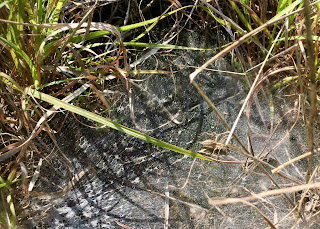 |
| The last hike of 2017 into Madrone Canyon. |
 |
| Jean points out a Texas madrone (Arbutus xalapensis) sapling among a motte of Ashe juniper (Juniperus ashei) trees. |
More from Jean on the history and usefulness of Hill Country cedar trees: "Many of the older cedar trees in the Canyon show signs of having been chopped. Between the late 1800s and early 1900s, cedar wood was in high demand. The rapidly-expanding railroad industry needed cedar logs for railroad ties. Cedar wood was used for making charcoal for heating and cooking, and houses were built on cedar piers. The Texas Hill Country was a major supplier of cedar far and wide, and we can see the many straight edges of cut branches that indicate the work of cedar choppers. Looking across the Canyon, however, it is clear that for several decades, nothing has disturbed the growth of cedar here. The abundant pollen of the male trees (which causes many folks to suffer cedar fever in the winter) has continued to fertilize the blue berries of the female trees. The birds have eaten the berries and dropped the seed, and seedlings have grown thick throughout the Canyon. In time, some of the trees will grow taller and wider, and many of the young trees will die from lack of light, opening the dense undergrowth and creating a thick layer of cedar duff (fallen leaves and decomposed branches to support seedlings of other plants. Cedar duff is a valuable element in our local forest ecosystems. Not only does it create a rich, light growing medium for Madrone seedlings, among many other species, it helps to retain water and slow erosion. The next time you walk through the Canyon, or any other cedar forest in the Hill Country, notice the thick layer of duff under the larger cedar trees and see how many seedlings of other plants are growing there. Along the trail, you are likely to see small berms of cedar duff that has accumulated during rain water run-off. These berms slow the water flow, allowing the water to sink into the soil and keeping more of the soil in place. The Madrone trees in the Canyon are most often found growing in very close proximity to cedar trees, and it is thought that Madrones may benefit from a mycorrihizal relationship with the soil fungi and the cedar trees. Though some people take a dim view of cedar in our area, these are some reasons to appreciate it."
Ashe Juniper is considered by the Wasowski’s (Native Texas Plants) to be the most important tree in the Edwards Plateau.
One member of our hiking group commented that the flavor of the juniper berries reminded him of the taste of gin. I was curious about that, so I went to the book Remarkable Plants of Texas by Matt Warnock Turner, my go-to book for medicinal, culinary and cultural practices with Texas native plants to find out more. On page 42, it states, "The berry of the common juniper of Europe (J. communis) is one of the main flavoring ingredients of gin, which is reflected in the somewhat bitter taste of the alcohol." We have some very insightful hikers!
We hope to see you in 2018!
Paula and Jean





















